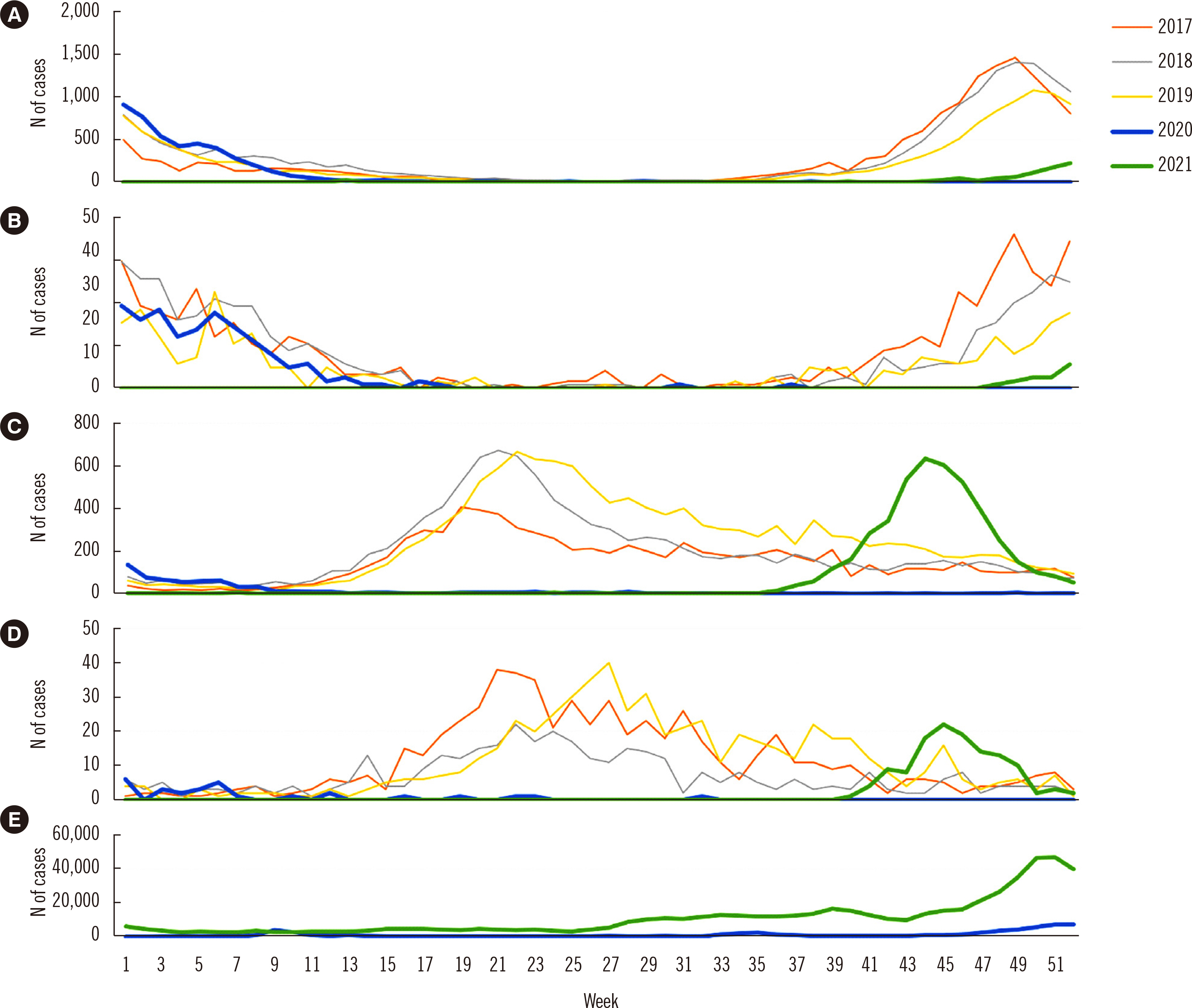Ann Lab Med.
2023 Jan;43(1):114-116. 10.3343/alm.2023.43.1.114.
Reemergence of Parainfluenza Virus Type 3 and Respiratory Syncytial Virus Infections During the COVID-19 Pandemic
- Affiliations
-
- 1Department of Laboratory Medicine, Asan Medical Center, University of Ulsan College of Medicine, Seoul, Korea
- KMID: 2551614
- DOI: http://doi.org/10.3343/alm.2023.43.1.114
Figure
Reference
-
1. Song JY, Yun JG, Noh JY, Cheong HJ, Kim WJ. 2020; Covid-19 in South Korea - Challenges of subclinical manifestations. N Engl J Med. 382:1858–9. DOI: 10.1056/NEJMc2001801. PMID: 32251568. PMCID: PMC7154984.
Article2. Ministry of Health and Welfare. Coronavirus (COVID-19), Republic of Korea. http://ncov.mohw.go.kr/en/. Updated on 11 Jan 2022.3. Park IN, Yum HK. 2020; Stepwise strategy of social distancing in Korea. J Korean Med Sci. 35:e264. DOI: 10.3346/jkms.2020.35.e264. PMID: 32686376. PMCID: PMC7371458.
Article4. Jefferson T, Del Mar CB, Dooley L, Ferroni E, Al-Ansary LA, Bawazeer GA, et al. 2011; Physical interventions to interrupt or reduce the spread of respiratory viruses. Cochrane Database Syst Rev. 2011:CD006207. DOI: 10.1002/14651858.CD006207.pub4. PMID: 21735402. PMCID: PMC6993921.
Article5. Ahmed F, Zviedrite N, Uzicanin A. 2018; Effectiveness of workplace social distancing measures in reducing influenza transmission: a systematic review. BMC Public Health. 18:518. DOI: 10.1186/s12889-018-5446-1. PMID: 29669545. PMCID: PMC5907354.
Article6. Ujiie M, Tsuzuki S, Nakamoto T, Iwamoto N. 2021; Resurgence of respiratory syncytial virus infections during COVID-19 pandemic, Tokyo, Japan. Emerg Infect Dis. 27:2969–70. DOI: 10.3201/eid2711.211565. PMID: 34388086. PMCID: PMC8544984.
Article7. Lee SJ, Lee SH, Ha EK, Sheen YH, Sung MS, Jung YH, et al. 2017; Prevalence of respiratory virus infection with regard to age, sex, and seasonality factors: a single center experience against children hospitalized during the 10 years. Allergy Asthma Resp Dis. 5:320–5. DOI: 10.4168/aard.2017.5.6.320.
Article8. Park JY, Kim HI, Kim JH, Park S, Hwang YI, Jang SH, et al. 2021; Changes in respiratory virus infection trends during the COVID-19 pandemic in South Korea: the effectiveness of public health measures. Korean J Intern Med. 36:1157–68. DOI: 10.3904/kjim.2021.026. PMID: 34399570. PMCID: PMC8435496.
Article9. Korea Disease Control and Prevention Agency. COVID-19 vaccination. https://ncv.kdca.go.kr/eng/. Updated Jan 2022.10. Ibrahim NK. 2020; Epidemiologic surveillance for controlling Covid-19 pandemic: types, challenges and implications. J Infect Public Health. 13:1630–8. DOI: 10.1016/j.jiph.2020.07.019. PMID: 32855090. PMCID: PMC7441991.
Article
- Full Text Links
- Actions
-
Cited
- CITED
-
- Close
- Share
- Similar articles
-
- Recovery of respiratory syncytial virus, adenovirus, influenza virus , and parainfluenza virus from nasopharyngeal aspirates from children with acute respiratory tract infections
- Shift in Clinical Epidemiology of Human Parainfluenza Virus Type 3 and Respiratory Syncytial Virus B Infections in Korean Children Before and During the COVID-19 Pandemic: A Multicenter Retrospective Study
- Respiratory Syncytial Virus Infections and Application of Nested Reverse Transcription-Polymerase Chain Reaction
- Nosocomial respiratory syncytial virus infection in a newborn nursery
- Clinical characteristics of acute viral lower respiratory tract infections in hospitalized children in Seoul, 1996-1998



